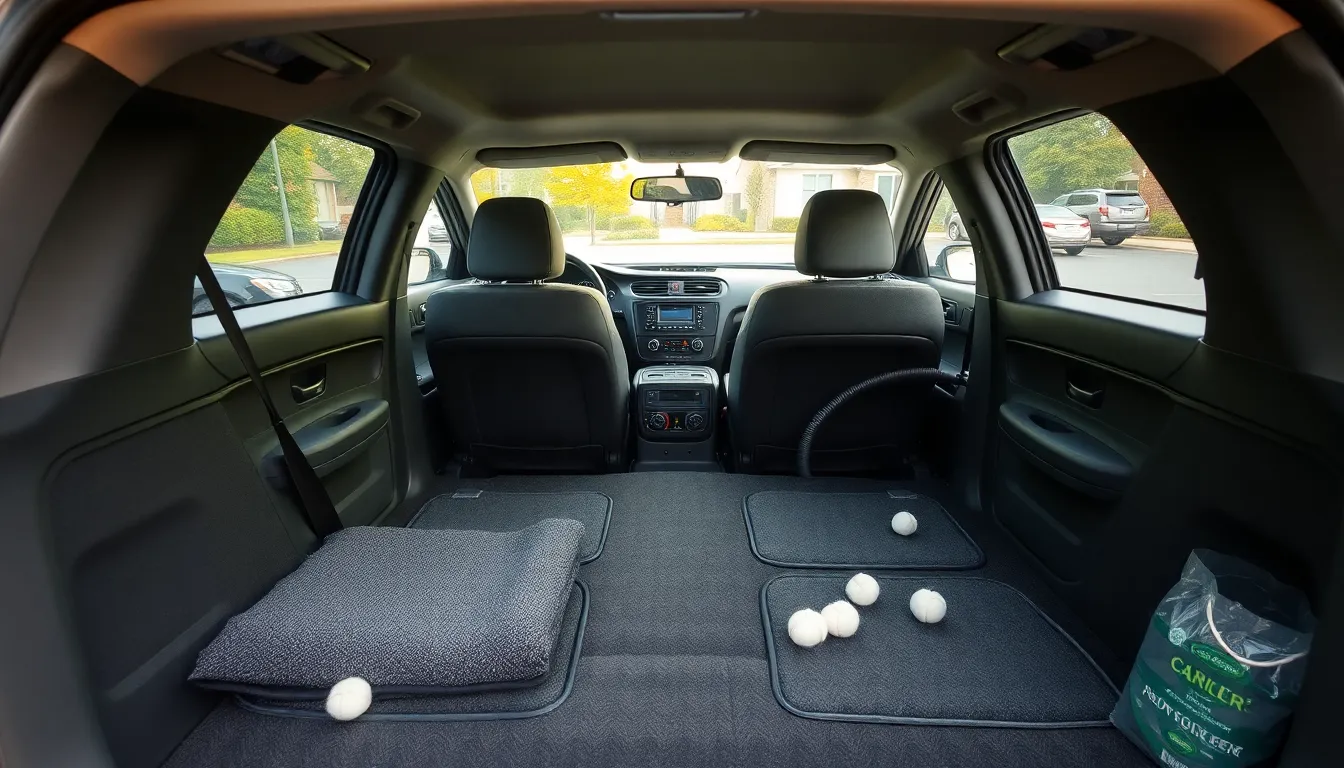Finding mice in a car can be a frustrating experience for any vehicle owner. These tiny invaders can cause significant damage if left unchecked, chewing through wires and nesting in hard-to-reach areas. Understanding how to effectively remove them is crucial for protecting both the car and its occupants.
In this article, readers will discover practical strategies to evict mice from their vehicles. From identifying signs of an infestation to employing humane removal techniques, the guide will provide essential tips for ensuring a mouse-free ride. With the right approach, anyone can reclaim their car from these unwelcome guests and prevent future infestations.
Table of Contents
ToggleUnderstanding the Problem: Mice in Your Car
Mice in cars pose significant challenges, leading to damage and health risks. Recognizing the signs of an infestation and understanding its implications is essential for effective removal.
Common Signs of Mice Infestation
- Droppings: Small, dark pellets indicating recent activity.
- Nests: Groups of shredded materials found in hidden areas, often made of fabric or paper.
- Gnaw Marks: Visible marks on wiring or interior components signaling mouse chewing.
- Odors: Unpleasant smells from urine or nesting sites.
- Sounds: Scratching or scurrying noises, especially at night.
Risks of Mice in Your Vehicle
- Damage to Wiring: Mice chew on electrical wires, leading to potential short circuits and costly repairs.
- Contamination: Droppings and urine can contaminate the car’s interior, posing health risks to occupants.
- Fire Hazards: Chewed wires can create fire risks if insulation is compromised.
- Value Decrease: Infestations can lower the resale value due to damage and lingering odors.
- Pests Attraction: A mouse infestation can attract other pests, exacerbating the problem.
Effective Prevention Strategies

Implementing effective prevention strategies is crucial for keeping mice out of vehicles. Maintaining cleanliness and using deterrents can significantly reduce the likelihood of infestations.
Keeping Your Car Clean
Maintaining a clean environment inside the car prevents mice from developing a habitat. Regularly removing food items, wrappers, and trash eliminates potential food sources. Vacuuming seats, carpets, and floor mats removes crumbs and debris that attract pests. Parking in clean, dry areas and ensuring no food or other attractants remain in the vehicle helps deter mice from entering. Inspecting the car periodically for signs of nesting material or droppings provides early detection of any issues.
Using Deterrents and Repellents
Employing deterrents and repellents can effectively discourage mice from entering vehicles. Placing natural repellents, such as peppermint oil-soaked cotton balls, in various crevices emits an odor that mice avoid. Commercial repellents, available in both spray and granular forms, also deter rodents effectively. Ultrasonic devices emit sounds that are disruptive to mice, providing an additional layer of deterrence. Sealing any entry points, such as gaps in the engine compartment or undercarriage, minimizes access for mice and further protects the vehicle.
Step-by-Step Techniques to Remove Mice
Effective removal techniques are essential for dealing with mice in cars. These methods involve inspection, trapping, and using repellents to ensure thorough elimination.
Inspecting Your Vehicle
- Check for Signs: Look for droppings, nests, or gnaw marks in the interior and engine area. Mice often leave behind clumps of droppings or chewed insulation as indicators of their presence.
- Examine the Storage Areas: Inspect compartments, under seats, and in the trunk for hidden nests or food items. Mice frequently seek out dark, concealed spaces.
- Verify Entry Points: Identify and assess potential entry points, such as gaps in the undercarriage or around wiring. Fixing these openings reduces future infestations.
- Monitor for Sounds: Listen for scratching or scurrying noises while the vehicle is stationary. These sounds may indicate active mice.
Setting Traps Safely
- Choose the Right Traps: Use humane traps to capture mice without harming them. Options include catch-and-release traps that allow for safe relocation.
- Position Traps Correctly: Place traps in areas where signs of mice have been found. Effective locations include under seats, within storage compartments, and near suspected entry points.
- Bait Wisely: Use enticing bait such as peanut butter, seeds, or dried fruit to attract mice. Ensure bait is secured within the trap for best results.
- Check Regularly: Inspect traps daily to monitor successful captures. Promptly remove and relocate any captured mice to minimize stress.
- Maintain Cleanliness: After trapping, clean the vehicle thoroughly to remove any scents that may attract further infestations. Regular cleaning helps deter future mice from entering.
Dealing with Potential Damage
Identifying and addressing potential damage caused by mice in a car is crucial for maintaining vehicle integrity and safety. Mice can compromise various components, which necessitates thorough inspection and prompt action.
Assessing for Nesting and Chewing
Inspect the vehicle for signs of nesting materials, such as shredded fabric or insulation. Check hidden areas, including the undercarriage and behind panels, as these often serve as nesting sites. Look for chewing marks on wires, rubber hoses, and upholstered surfaces. Mice tend to gnaw on various materials, which can lead to expensive repairs. Document the extent of damage when assessing, as this information aids in determining necessary repairs or professional assistance.
Cleaning and Repairing Affected Areas
Clean contaminated areas to eliminate odors and potential health risks. Use a mixture of water and vinegar or a disinfectant designed for automotive use. Ensure all droppings, urine, and nesting materials are completely removed to prevent attracting other pests. For any damaged wiring or components, replace these parts promptly to maintain vehicle functionality. If significant damage occurs, consider consulting a professional mechanic to complete repairs and ensure the vehicle’s safety.
Dealing with mice in a car requires prompt action and effective strategies. By understanding the signs of an infestation and employing humane removal techniques, car owners can reclaim their vehicles and prevent future problems. Maintaining cleanliness and sealing entry points are crucial steps in keeping mice at bay.
Regular inspections and prompt repairs of any damage caused by rodents will help ensure the vehicle remains safe and functional. With the right approach, it’s possible to create an environment that discourages mice from making a home in the car. Taking these measures not only protects the vehicle but also contributes to a healthier driving experience.









